| Columns Retired Columns & Blogs |
all five USB connectors on the 151 are of the USB-A type...
I tested the Burmester 151 Musiccenter MK2 with my Audio Precision SYS2722 system, controlling it with the Burmester app on the included iPad mini. (After I connected the Musiccenter to my network, the iPad app communicated with it via Wi-Fi.) I used coaxial and optical S/PDIF data, test CDs, and WAV files on a USB stick inserted into one of the rear Type A USB ports. (The Burmester was set to recognize USB files automatically and switched the app to the appropriate Player page when I plugged in the USB stick.) The volume can be set to Variable, with a choice of four maximum levels, or to Fixed, with or without Volume Normalization. JVS used the latter setting for most of his auditioning, with 192kHz upsampling, so that is how I performed the majority of the tests.
The maximum output level in Variable mode set to Medium was 2.3V, balanced, and 1.15V, unbalanced, with a 1kHz signal at 0dBFS. The Low setting reduced this level by 10dB, High increased it by 3dB, and Very High by 6dB. The two highest settings resulted in waveform clipping when the volume control was set to its maximum. In the Burmester's fixed-output mode, the S/PDIF inputs can be set to a maximum output level ranging from –6dB to +6dB referenced to a nominal 0dB. I left them set to "0.0dB." In Fixed mode, the output level with S/PDIF data at 0dBFS was 4.167V, balanced, and 2.083V, unbalanced. The maximum output level with both CD playback and USB data was half these levels, which suggests that the output for these sources is fixed at –6dB. (I couldn't find an iPad app setting that allowed this to be changed with these sources.)
The 151 Musiccenter's balanced output impedance was a moderately low 514 ohms from 20Hz to 20kHz. The single-ended output impedance was half the balanced, as expected. The Burmester's impulse response, examined at the balanced outputs with 192kHz upsampling and the Phase set to "0 Degrees" (fig.1), indicates that it inverts absolute polarity. Repeating the measurement at the unbalanced output gave the correct, noninverted polarity. The XLR output jacks must therefore be wired with pin 3 positive, the opposite of the AES standard. The Musiccenter's impulse response with 96kHz upsampling and with CD data was identical. The digital reconstruction filter is a conventional linear-phase type, with equal amounts of ringing before and after the single sample at 0dBFS.
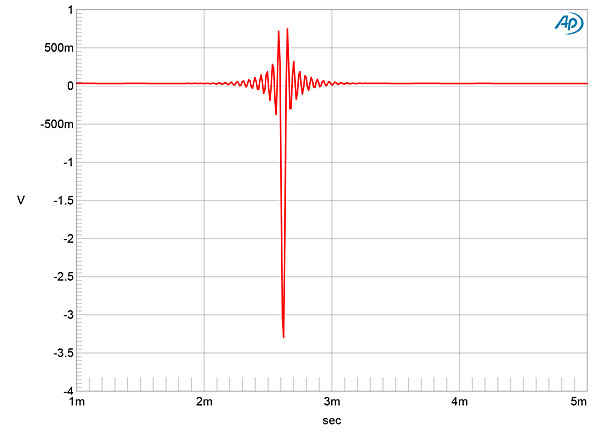
With 44.1kHz white noise at –4dBFS and 192kHz upsampling (fig.2, red and magenta traces), the 151 MK2 Musiccenter's response was flat up to 20kHz then rolled off sharply, reaching full stop-band suppression at 24kHz, just above the Nyquist frequency of 22.05kHz (green vertical line). The distortion harmonics associated with a full-scale tone at 19.1kHz (blue and cyan traces) were very low in level, and the aliased image at 25kHz of this tone is absent. The spectrum was identical with 96kHz upsampling and with all digital sources.
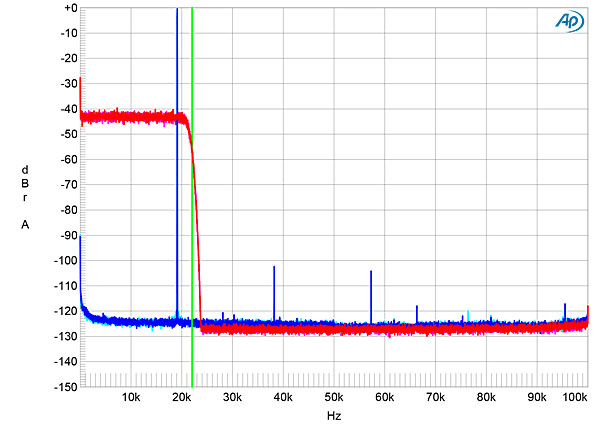
The 151 Musiccenter's frequency response with 192kHz sampling followed the same basic shape at sample rates ranging from 44.1kHz (fig.3, green and gray traces) to 192kHz (blue and red traces), with a sharp rolloff just below the Nyquist frequency at sample rates lower than 192kHz. The response with 192kHz data but 96kHz upsampling (fig.4) followed the same shape up to 47kHz as the cyan and magenta traces in fig.3, which were taken with 96kHz data, but was corrupted by aliased images above that frequency. This won't have audible consequences, but for best technical performance, leave the Musiccenter set to 192kHz upsampling. Channel separation (not shown) was superb, at >120dB in both directions below 2kHz and still 110dB at 20kHz. The low-frequency noisefloor, examined with a 1kHz tone at 0dBFS, was clean (fig.5), with no power supply–related spuriae present.
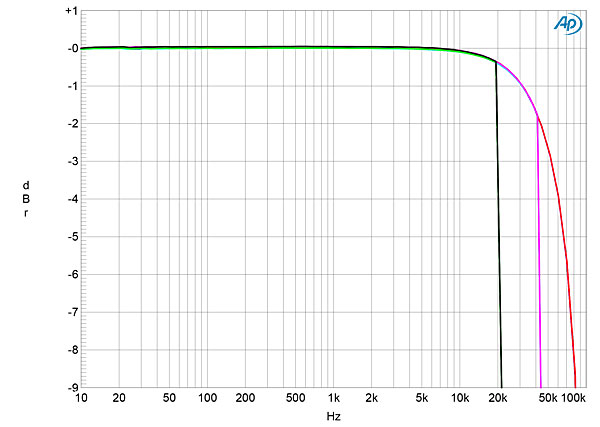
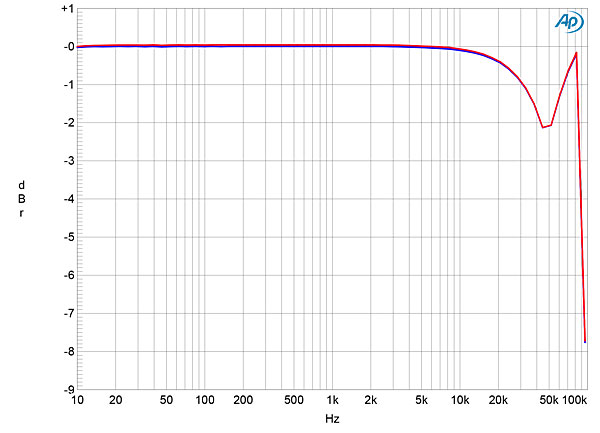
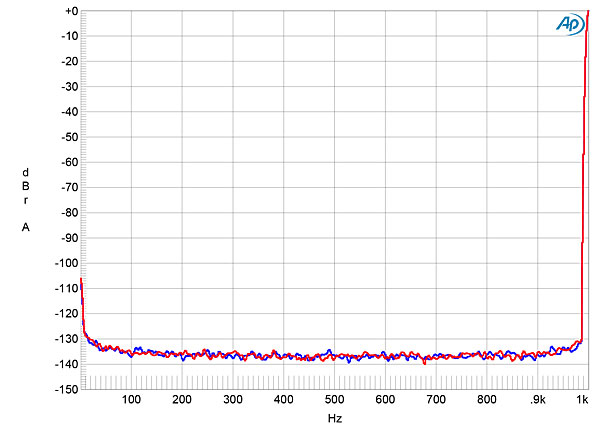
Fig.6 shows the 151 Musiccenter MK2's output spectrum with a dithered 1kHz tone at –90dBFS with 16-bit data (cyan and magenta traces) and 24-bit data (blue and red traces). With the 16-bit data, the noisefloor is that of the dither used to encode the signal. With 24-bit data, the random noisefloor drops by 20dB, which suggests a resolution of slightly more than 19 bits.
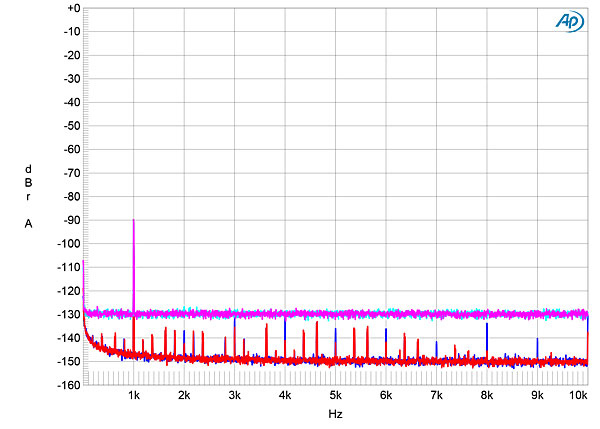
A regular series of very low-level spurious tones is present. This graph was taken with 192kHz upsampling; there was no change with 96kHz upsampling. With a dithered 24-bit tone at –120dBFS (fig.7), the spectrum was clean other than some low-order harmonics at or below –130dB. With undithered 16-bit data representing a tone at exactly –90.31dBFS (fig.8), the three DC voltage levels described by the data were well resolved, and the waveform was perfectly symmetrical. With undithered 24-bit data, the Burmester reproduced a relatively clean sinewave (fig.9).
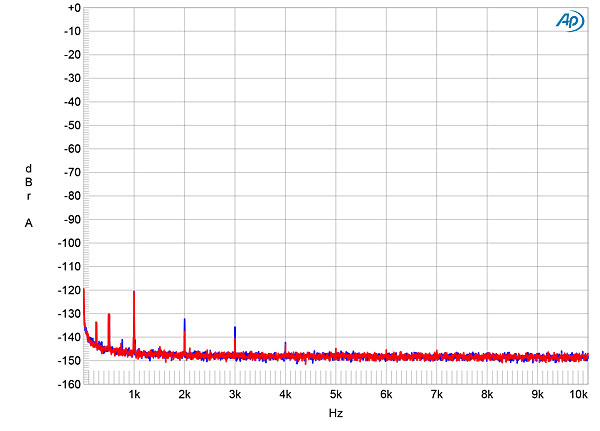
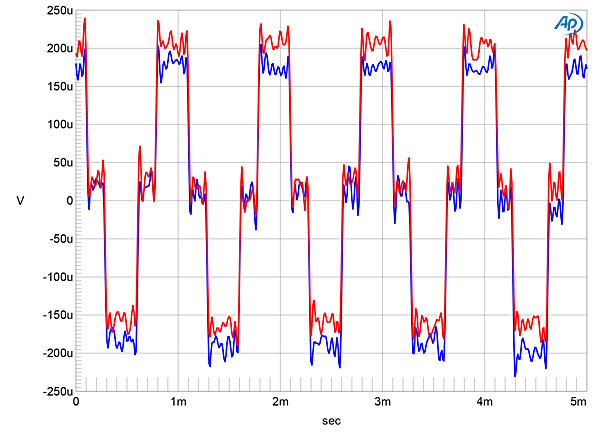
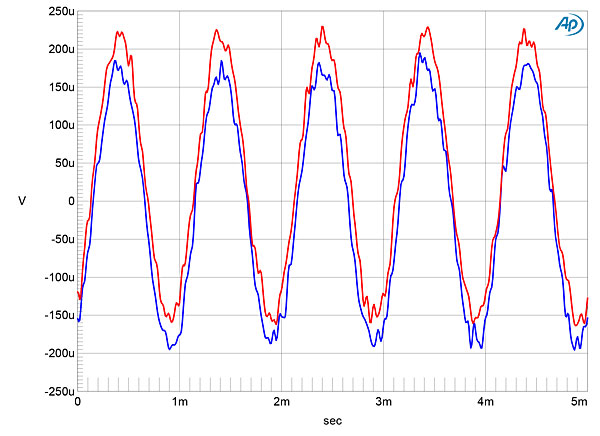
The Burmester featured very low levels of harmonic distortion, with the third harmonic the highest in level at –106dB (0.0005%) with 24-bit data (fig.10). Commendably, the level of this harmonic didn't increase when I reduced the load to 600 ohms. The spectrum of the 151 Musiccenter's output while it reproduced a mix of equal levels of 19 and 20kHz tones, the signal peaking at 0dBFS, is shown in fig.11. All the intermodulation products lie at or below –120dBFS (0.0001%). As expected from fig.2, no aliased images of the tones are present. This spectrum was taken with 192kHz upsampling into 100k ohms. It didn't change with 96kHz upsampling or into 600 ohms.
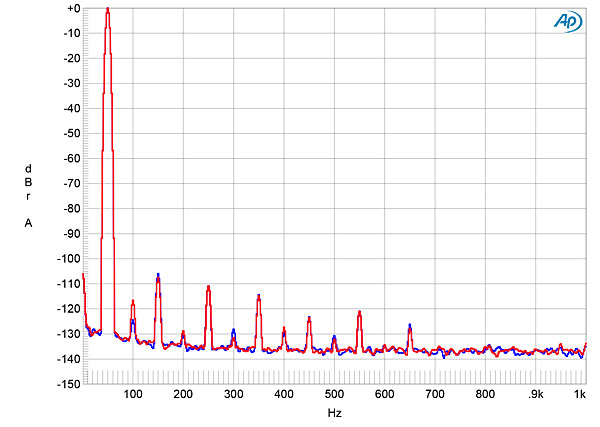
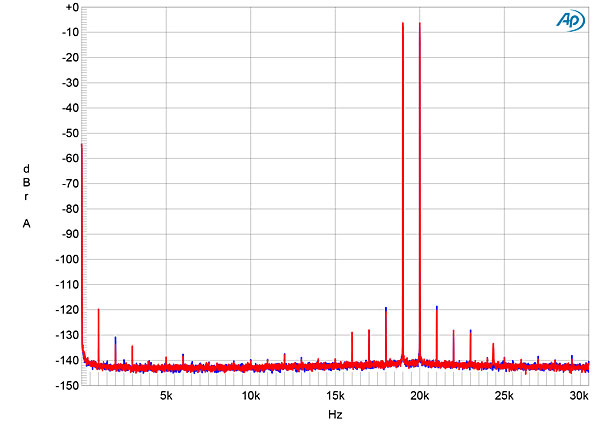
I tested the 151 Musiccenter's rejection of word-clock jitter with the undithered Miller-Dunn J-Test signal sourced via S/PDIF with a 15' plastic optical cable, which will be the worst case. The Burmester reproduced the odd-order harmonics of the LSB-level, low-frequency squarewave very close to the correct levels (fig.12 sloping green line), and no other sidebands were present. With 24-bit J-Test data (fig.13), the spectrum was clean.
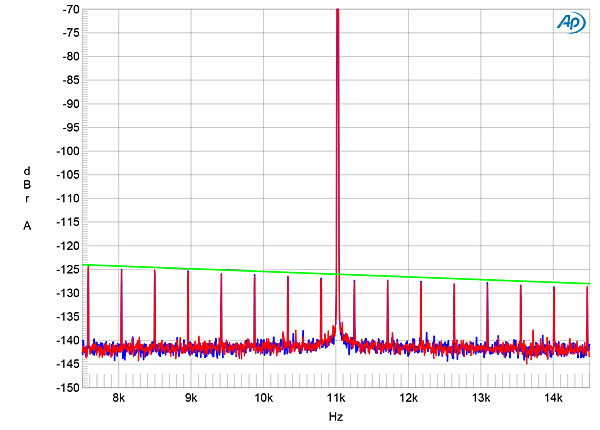
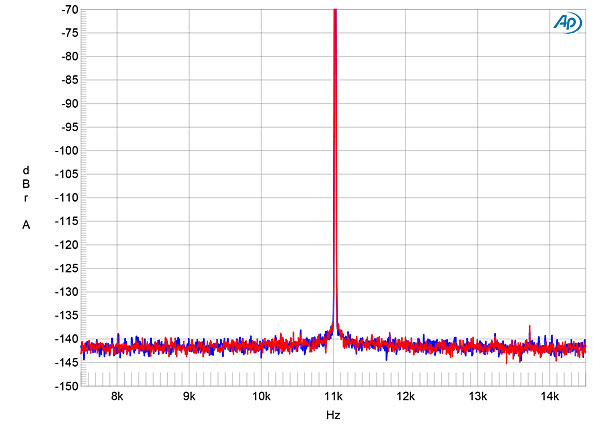
As the Musiccenter can be used to play CDs, I used the Pierre Verany Digital Test CD, which has gaps of various lengths in the data spiral, to check its error correction. The Compact Disc Standard requires only that a player cope with gaps of up to 0.2mm in length, but the 151 Musiccenter played all the tracks without audible glitches, though it did hesitate briefly before playing the track with a 4mm gap in the data. This superb error correction/concealment is appropriate for a transport that can be used to rip CDs.
Although JVS didn't audition the 151 MK2 Musiccenter's balanced analog inputs, I performed a basic set of measurements using those inputs. The input impedance was 9.2k ohms and, as with the digital inputs, the balanced outputs inverted the absolute polarity of analog input signals. The single-ended outputs were noninverting. In fixed-output mode, the gain was unity at the balanced outputs—ie, an input of 1V resulted in an output of 1V—and 500mV, –6dB, at the unbalanced outputs. In Variable mode, the maximum gain was unity (0dB) set to Medium, –10dB set to Low, +3dB set to High, and +5.8dB set to Very High.
The analog inputs offered a wide frequency response, with the output down by 3dB at 180kHz (fig.14). Channel separation via the analog inputs was even higher than it had been for the digital inputs, at >130dB below 10kHz, and distortion was very low, reaching 0.0002% at 2V output. Set to unity gain and driven by an analog input signal, the balanced analog outputs clipped at 10V into 100k ohms, well above what will be required in real-world use.
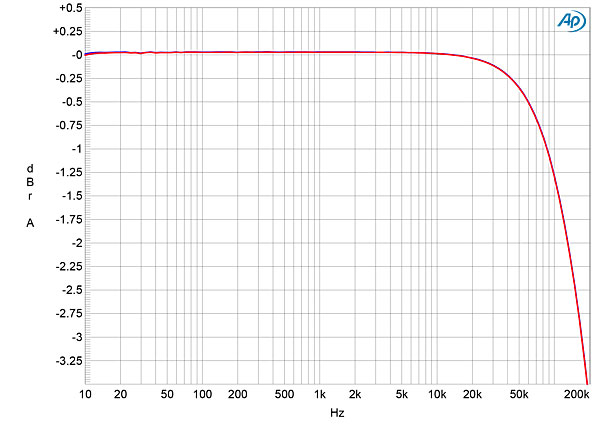
I was initially concerned by the non-integer upsampling of 44.1kHz data—integer sample-rate conversion is preferable, as this means that every second or fourth sample in the upsampled data is the same as the original data. However, the Burmester 151 MK2 Musiccenter's performance on the test bench indicates excellent audio engineering in both the digital and analog domains. It gets a clean bill of health from this measurer.—John Atkinson

"The 151 MK2's playback options are numerous. It can play files from USB sticks: There's a USB-C input on the front panel for convenience."
h

if you can cram a USB-C stick into that front socket & get it render music :) check out p. 20 of the 151's manual, it's USB-A up front as well...

You were right and I was wrong,
I apologize for not doing my due diligence.
herb

This is a common problem with music server software generally. Once the music is ingested, everything works fine, but ingesting music and setting up a library is an error-prone process. Fixing it up—in my experience at least—requires a certain amount of competence in information technology.
This is certainly true but I think it is much more significant for proprietary servers, such as the Burmester under review and the many other dedicated boxes whose embedded firmware does not support editing/tagging functions. That category includes those which run under such proprietary systems as HEOS and BlueOS. In all of these, the metadata has to be managed by some external device. Software-based systems that run Roon, Jriver, Audirvana, etc., have internal tagging/editing functions that can manage these tasks internally and more easily.

Kal,
I'm not as familiar with some of the other systems you listed, but I know that for years Roon--which I otherwise greatly admire and use daily--refused to take any responsibility for ingesting music, and even today, its functionality in that regard is limited. It does fine for mainstream first releases, but it struggles with repackaged reissues--especially multidisc boxed sets.
I'll stand behind the assertion that for all these systems, not just the "proprietary" ones, ingestion of music remains a struggle.
Jim Austin, Editor
Stereophile

I was being generous to Roon because of its rich data resources that, afaik, dwarfs those of all other players. That is the reason I included it with the other software packages that I've used even though they really limit the user's ability to edit and manipulate metadata. OTOH, the contrast between players that simply "ingest" music and those that offer the facilities to manage/edit/reconfigure music data and display preferences seems to correspond to the distinction between embedded proprietary players and those that are software based.
I'll stand behind the assertion that for all these systems, not just the "proprietary" ones, ingestion of music remains a struggle.
Yes but ingestion is improved if the input is correctly prepared, flavored and presented to please the palate. The music players that provide useful tools help me insure that.

This is a not a quality review.
I could tolerate unrepentant subjectivity from Art Dudley because of his amusing style, but not from JVS with his empty blather, e.g., "music sings supreme."
There is evidence of poor design with this device-- e.g., "We never make products intentionally complex,"-- yet it sounds like a very unintuitive interface.
Big red flag-- the designer was cagey about which chip is used! Couldn't the reviewer take a peek at the innards? Nothing about the volume control? Coupling caps?
The designer claims "SUBSTANZ" but the reviewer has a duty to apply KRITIK to such claims. This review mostly regurgitated the company line and as such is unhelpful.
For me to regain confidence in JVS, I suggest that he undertake some blind ABX demonstrations to verify his listening ability. Particularly with more subtle devices like a DAC, or a preamp, a reader like me would like to know if any difference is detectable or not.
PS: My primary objection here is a failure to look beyond the marketing BS of the seller. I don't expect a reviewer to be an electrical engineer, but the failure to look under the hood is journalistic malpractice. And to be clear, I'm not asking reviewers to do ABX for every review. It's laborious, time-consuming and risky to one's credibility. But when a review fails to enlighten, a little investment in the scientific rigor of ABX listening would bring us all out of the Dark Ages of total BS. It's the bridge between fanciful subjectivity and honest objectivity.
PPS: I do appreciate the music reviews from JVS. But his product reviews strike me as deeply lacking.

Hi
Agreed. A good reviewer should override the usual marketing/sales pitches provided by the vendors & provide hands-on using/audition experience of the product under review as if a potential purchaser of the product.
That's what we audio consumers go after.
Listening is believing
Jack L

to be exposed to the world at large for business reasons. No consumer by rights of purchase is guaranteed access to technology IP. If they sealed the dac module, would some suggest to bust it open to get to the 'truth'?
The same holds true for the manufacturer. Many simply aren't going to share their trade secrets. It's nice to pretend that consumer transparency is attainable, but I don't think it is. Should the manufacturer lay out their engineering design choices in a crowded field of competition? Do other industries do this, even a bit? No, they don't.
Some feel JVS' music reviews are trustworthy and his product reviews are not. The lack of trust lies more at the poster than the author. I also believe Burmester has a product that JVS states as he hears it. All else is idealistic dross to demand more.

Many high-end preamp reviews display the innards so we can behold the handiwork, e.g., surprisingly NAGRA uses a $10 ALPS pot, while Shindo uses a somewhat less ordinary Tokyo Cosmos pot. And DAC reviews normally indicate the chip or R2R selection. I don't expect a full "open the kimono" from the designer, but here the designer was SO cagey that it's a red flag begging for scrutiny. It's a $30K preamp-DAC! Is it too much to ask a few simple questions? My pre costs much less, and I know about its choke filter and its coupling caps and the different tubes and the pot and the transformer. It's part of the hobby.
Moreover, Burmester makes speakers and preamps and amps and car audio. So are they great at everything? (unlikely) Maybe they're more like Bose. A pricey brand with disappointing SUBSTANZ behind the big prices.

I guess if JVS is used to a very high level of sound reproduction, you would know that he feels Burmester's caliber of sound is definitely up to that benchmark.
We may all disagree of the slight variances in playback preferences, but I firmly believe he would state if the component was so far off the class price point, there would be several mentions throughout the review. Funny thing is, these days you really don't need to take his word for it.
As HR states somewhere in the recent AXPONA posts, this show is really an important time to hear these literally million dollar systems from several manufacturers in a number of disparate systems. This is to directly compare the highest of the high end sound systems extant from companies who offered their very own tip to tail system- like Burmester.
I found their room at 6pm Saturday- too late. (And I already partied the night before in downtown Chicago catching Wilco.) I was bummed- but I won't put forth assumptions as I haven't heard their gear and didn't talk to their staff, also at AXPONA.
Audio shows are really important for figuring out value behind component pricing (and system-matching!). I'm sure we all wanna know about all tech going into gear, but I don't feel that I have a right to demand it. There are exceptions.

I look forward to hitting one of these shows to listen for myself.
But insofar as the readers of Stereophile rely on the staff who attended this show, the issues of trust and confidence come into play. And I must disagree with this conclusory statement: "I guess if JVS is used to a very high level of sound reproduction, you would know that he feels Burmester's caliber of sound is definitely up to that benchmark." There were enough missteps in this review and other recent JVS reviews that I respectfully suggest a blind listening demonstration. The simplest ABX test would be a few DACs connected to the same preamp-amp-speakers. Think of it like a driver's test. Especially once people get older, we're all better off it older drivers recertify their ability. I remember Mr. Atkinson did an ABX to establish if he could hear phase/polarity and he passed the test:
https://www.stereophile.com/content/listening-tests-and-absolute-phase
"The listener's capacity for self delusion so that he really does hear differences which are nonexistent in reality (but enjoy a healthy existence in the pages of magazines) when he is aware of the device being tested, I would say is practically infinite."

Hope to see you at a show I'm covering some day. But please don't shout when you see me; my ears are very sensitive.
Thanks so much,
jason

or just the arguments of these pages, I could agree with you in several of your arguments. Without exposure to those high-priced systems, one has absolutely no reference point whatsoever to the current reality of state-of-the-art music playback.
The 'capacity for self-delusion' comment is so far off the mark, it's as if one has been sitting outside the concert venue simply watching behind a glass window, while others are inside listening first-hand. (No offense intended whatsoever.)
To hear the entire Burmester system or any of the least 20 other rooms that were at the absolute cutting edge of reproduction is to finally say to oneself- "Oh, sorry. I had no idea of how accomplished reproduction is these days". Million dollar systems are utter and complete ear-openers.
You really should go at your nearest opportunity. Take the entire weekend to fully appreciate all of the various performance levels provided in the 100+ rooms.

Next time there's a SoCal audio show, I'm going. My listening experience is confined to concerts and demos at the local dealers, and of course my own systems. What I don't like about the audio show setup is that the marketers are using THEIR chosen recordings.
If you don't think there's self-delusion in audiophilia, I'm not sure where to start. Perhaps Thinking Fast and Slow?

They frequently asked me what I would like to listen to in various demos I attended. Since many if not all are also streaming content, it is very possible they can play anything you request.
Regarding your last statement, I think it's rather the other way around. Perhaps 30 years ago when much of luxury audio was still very nascent, but even then I've heard very stable and accurate demos in the 1990's, albeit it was much more rare.
When you go to the next show, it will become starkly obvious the level of quality that is on display there. Splitting hairs about the top-tier components (and the ones in reviewed in JVS' system) will appear to be just that. At AXPONA, most if not all manufacturers were fully represented in live rooms, including D'Agnostino, Wilson, DCS and Nordost. It's as simple as a listen. I would be nothing less than stunned if all weren't impressed.